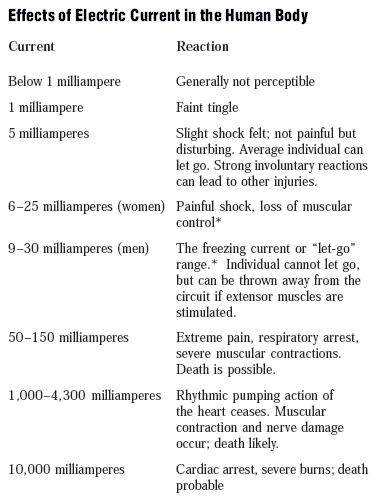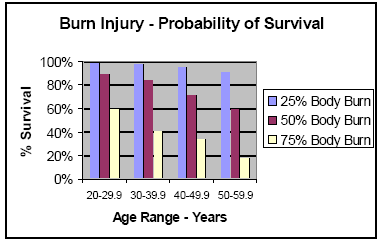The main points of this article are to offer the reader with an awareness of the generally dangers of electricity, and to provide some insight into the physiological effects of electrical shock on the human body. The main part of the article will centre of attention on the physiological effects of electrical shock on the human body. Electric power is a main form of energy world-wide. It helps us in living enhanced, but it is still a hazard in our everyday life. The human body uncovered to the electromagnetic field is presented as a thick conducting cylindrical scattered of the length L and radius a, placed vertically on the ideal ground.
When a human touches a large ungrounded metal object (like a car, truck, etc.), the total impedance between the entity and ground can be signified by a series combination of circuits equivalent to the electrode, skin and increase impedances, impedance between the feet and ground, and body impedance. Electric accidents’ figures, especially on work-related accidents, demonstrate the extent of the problem: electrocutions are the second causation for deaths at the workplace after falls from height. Actions for preventing occupational accidents have been taken in the various countries. The EU structure Directive for protection and health at work provides several requirements. Electricity has long been recognized as a grave workplace hazard, revealing employees to electric shock, electrocution, burns, fires, and explosions.
An electric shock can happen upon make contact with of a human’s body with any resource of voltage high enough to cause sufficient current flow through the muscles or hair. The least current a human can feel is thought to be about 1 milliampere (mA). The current may cause tissue damage or fibrillation if it is adequately high. The discernment of electric shock can be different depending on the voltage, duration, current, path taken, frequency, etc. Current entering the hand has a entrance of perception of about 5 to 10 mA (milliampere) for DC and about 1 to 10 mA for AC at 60 Hz. Shock perception declines with increasing frequency, eventually disappearing at frequencies above 15-20 kHz.
An electric shock can effect in anything from a minor tingling sensation to immediate cardiac arrest. The severity depends on the following:
- The amount of current flowing through the body,
- The current’s path through the body,
- The length of time the body remains in the circuit, and
- The current’s frequency.
This table shows the general relationship between the amount of current received and the reaction when current flows from the hand to the foot for just 1 second.

Cardiac effects
Current can result meddling with nervous control, especially over the heart and lungs. Repeated electric shock which does not lead to death has been shown to cause neuropathy. When the current path is through the head, it appears that, with enough current, loss of awareness almost always occurs swiftly. The effects of electricity on the human heart are usually the most serious considerations when dealing with electricity, because this is how most fatalities of accidental electrocution die. Note that currents less than 5 mA are usually imperceptible, and currents above 100 mA are the lethal currents.
Currents in excess of 6 A can cause severe burns and connected trauma; currents above 20 A can physically dismember the body. Currents between 100 mA and 1 A are the most dangerous to the heart, and voltages between 50 V and 240 V are those that can readily produce these currents, if the skin is wet. According to Ohm’s Law and the low 1 kS value of the resistance of the skin, a 50 V source produces only 50 mA through the body, which is throbbing but usually not deadly. However, if the voltage is 120 V, the current becomes 120 mA; at 240 V, the current is 240 mA, both of which are right in the range of the currents nearly all dangerous to the heart.
Other issues affecting lethality are frequency, which is an issue in causing cardiac arrest or muscular spasms, and pathway, if the current passes through the chest or head there is an increased probability of death. From a main circuit or power division board the spoil is more likely to be internal, leading to cardiac arrest.
Burns
Burns are the most ordinary shock-related injury. An electrical accident can effect in an electrical burn, arc burn, thermal contact burn, or a combination of burns. Electrical burns are in the midst of the most sombre burns and require immediate medical attention. They occur when electric current flows through tissues or bone, generating heat that causes tissue damage. Arc or spark burns result from high temperatures caused by an electric arc or blast near the body.
Thermal contact burns are caused when the skin touches hot surfaces of overheated electric conductors, conduits, or other energized equipment. Thermal burns also can be caused when clothing catches on fire, as may happen when an electric arc is produced. In addition to shock and burn hazards, electricity poses other dangers. For example, arcs that result from short circuits can cause injury or begin a fire. Extremely high-energy arcs can spoil equipment, causing fragmented metal to fly in all directions. Even low-energy arcs can cause sadistic explosions in atmospheres that have flammable gases, vapours, or burnable dusts.

Freeze
When a person receives an electrical shock, occasionally the electrical stimulus causes the muscles to contract. This “freezing” effect makes the person powerless to drag free of the circuit. It is tremendously dangerous because it increases the length of exposure to electricity and because the current causes blisters, which diminish the body’s resistance and increases the current. Longer exposures at even quite low voltages can be just as dangerous as short exposures at superior voltages. Low voltage does not involve low hazard. In addition to muscle contractions that cause “freezing,” electrical shocks also can basis reflex muscle reactions.
These reactions can result in a wide range of other injuries from collisions or falls, including bone fractures, bruises, and even death. If a person is “frozen” to a live electrical contact, shut off the current instantly. If this is not possible, use boards, poles, or sticks made of wood or any other no conducting materials and safely push or pull the person away from the contact. It’s significant to act speedily.
Preventing Electrical Hazards
Nearly all electrical accidents result from one of the following three factors:
- Unsafe equipment or installation,
- Unsafe environment,
- Unsafe work practices.
Insulation
Proper insulation is required for Preventing Electrical Hazards. An insulator is any material with high resistance to electric current. Insulators-such as glass, rubber, mica, and plastic-are put on conductors to put off fires, shock, and short circuits. Before employees get ready to work with electric equipment, it is always a good idea for them to check the insulation before making a connection to a power source to be sure there are no exposed wires.
Subpart generally requires that circuit conductors be insulated to prevent people from coming into unintentional contact with the current. Also, the insulation should be suitable for the voltage and existing conditions, such as moisture, temperature, gasoline, oil, or corrosive fumes. All these factors must be evaluated before the proper choice of insulation can be made. Conductors and cables are marked by the manufacturer to show the maximum voltage and American Wire Gage size, the type letter of the insulation, and the manufacturer’s name or trademark. Insulation is often colour coded.
Guarding
Guarding of live parts may be accomplished by position in a room, vault, or similar enclosure reachable only to qualified persons; use of eternal, substantial partitions or screens to exclude unqualified persons; location on a suitable balcony, gallery, or podium elevated and arranged to exclude unqualified persons; or elevation of about 8 feet. Indoor electric wiring more than 600 volts and that is open to unqualified persons must be made with metal-enclosed equipment or enclosed in a vault or area controlled by a lock. In addition, equipment must be marked with proper vigilance signs.
Grounding
The “ground” refers to a conductive body and means a conductive connection, whether deliberate or accidental, by which an electric circuit or equipment is connected to earth or the ground plane. By “grounding” a tool or electrical system, a low-resistance path to the earth is calculatedly created. When properly done, this path offers suitably low resistance and has sufficient current carrying capability to prevent the build-up of voltages that may cause a personnel hazard.
Safety equipment for electric hazard prevention
- Eyewash units- Eyewash device used to irrigate and flush eyes exposed to a chemical substance. Performance needs such as surge rates and distances to the eyewash are recommended by ANSI Standard Z358.
- Safety shower- It is a unit people use to soak their entire body with water to remove a contaminant. Performance needs such as surge rates and distances from the shower to the hazard are recommended by ANSI Standard Z358.1.
- Splash-proof goggles- Goggles providing shield against splashes. Usually, these goggles have an indirect venting system to avoid fogging. These goggles are not gas tight.
- Safety glasses- Both the lenses and the frames must be ANSI approved, and side shields must be worn in the presence of flying objects such as machine-shop work where impact may arise from the side.
The control of electrical hazards is an imperative part of every safety and health plan. The measures optional in this article should be of help in establishing such a plan of control. The duty for this plan should be delegated to individuals who have a complete knowledge of electricity, electrical work practices, and the proper standards for fixing and performance. Everybody has the right to work in a safe milieu. Through cooperative efforts, employers and employees can learn to identify and remove or control electrical hazards.
References
- Dennis K. Neitzel, The Hazards of Electricity – Do You Know What They Are?. 2008. Web.
- WILLIAM F. BARRY, C. FRANK STARMER, ROBERT E.WHALEN, and HENRY D. McINTOSH. 2008. Web.
- Safety Electrical Hazards. 2008. Web.
- Personal Protective Equipment. 2008. Web.
- Electrical shock hazard protection. 1993. Web.